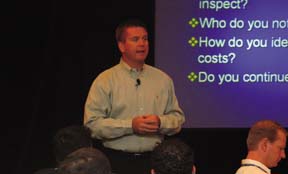
Every mechanical contractor remembers that one “mean and nasty” job. Or maybe they remember several. The Mechanical Contractors of America Association was banking on these memories during its Project Performance Conference “Assessing and Managing Risk/Reward,” Oct. 6-8, in Chicago. A group of nearly 100 business owners and project managers studied a recent monster-of-a-job - but still successful - hotel and convention center project completed by McKenney's Inc. in the Southeast.
The group learned new tools and practices into understanding risk/reward, and fundamentals were reinforced by John Koontz, MCAA's national director of project management, in order to better-manage labor productivity and improve job performance. Specific instances, such as dealing with mold on the job and a strained relationship with the GC, allowed the attendees to learn from each other during breakout sessions and group discussions.
The conference began with a keynote address by Chris Gardner, head of his own brokerage firm, who was once a homeless single-parent. His rags-to-riches story will soon be a major motion picture starring Will Smith. However, Gardner told the group, the story really wasn't about his rise to fortune, it was a love story: a father's love for his son, which broke a cycle of men not being there for their children.
The theme of breaking the cycle and exploring new avenues played throughout the conference. The project was unveiled by Tom Williams, conference leader and former president of the construction division of McKenney's. He presented the parameters of the hotel project: 700-room convention center and hotel; two banquet kitchens and two warming kitchens; multistory parking deck, etc. Then Williams told the backstory as McKenney's joined the project: First mechanical contractor had walked off; a form failure dropped 5,000 sq. ft. of concrete; fourth elevated slab was being poured; a room fan coil unit design was in dispute; and other problems presented themselves on site.
Williams asked the group, “Would you bid this job?” and the room was divided evenly with yes and no. Thus began the assessment of risk and reward in this industry.
Tim Wentz, faculty member for MCAA's National Education Initiative and Institute for Project Management, and Jan Mider, senior director of operations for Siemens Building Technologies, explained there are two types of risks: business risks and project risks. Wentz said business owners and their teams need to understand key elements in order to properly assess risk: financial, operational, environmental and strategic. Mider offered a look into management software, as well as project classification tools and making go/no-go decisions.
Koontz discussed the importance of measuring performance, which ultimately helps measure risks. He also stressed the need for proper scheduling, both requesting the GC's schedule and building your own. “As mechanical contractors, we know how things are built and designed. We can drive a project,” Koontz told the room. “A professional project manager puts together schedules and presents it to his customers. He is a proactive member of the construction team.”
Three-week “Look Ahead” schedules are also integral during projects because they can break down tasks into bite-sized pieces, Koontz said.
Other notable speakers at the conference included:
- Chris FitzGerald, president and COO of FitzGerald Contractors Inc., who gave attendees one of the most practical speeches on dealing with mold that this reporter has heard in a while.
- Engineer Chuck Graziano of McKenney's examined commissioning and how it can be used to alleviate project risk. He also explained how looking into design flaws early on can decrease risk.
- Construction consultant Paul L. Stynchcomb explored how labor and productivity can be measured as accurately as possible, and how lost labor can be reduced.